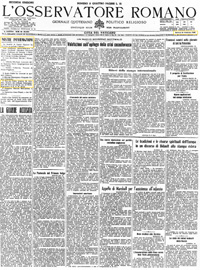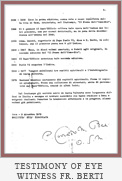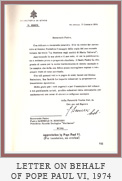1944~47: Maria Valtorta reportedly received visions and dictations regarding the life of Jesus, which were recorded into notebooks. These eventually became known in english as “The Poem of the Man-God”. [1]
[1] Maria Valtorta wrote over ten-thousand hand-written pages in three years, averaging about sixty-four pages per week (an additional five thousand pages were written and composed into other books and meditations until 1954, including an autobiography. All of her writings were done in obedience to her confessor's request. We note this final point because Church norms require obedience as a necessary condition for authenticity. Historically, a disobedient visionary almost guarantees falsity.).
1946: Archbishop Alfonso Carinci, Secretary of the Congregation of the Sacred Rites, reviewed the manuscripts and stated; "There is nothing therein which is contrary to the Gospel. Rather, this work, a good complement to the Gospel, contributes towards a better understanding of its meaning" 1
1946~47: Maria Valtorta’s spiritual director, Fr. Migliorini, began reading the manuscripts with enthusiastic devotion. Convinced of the divine origin of the writings, he desired to seek publication (despite Valtorta’s reluctance to do so), and proceeded to draft them into typescripts and distributed them in small pamphlets. [2a]Fr. Migliorini was then transferred to Rome, and was replaced by Fr. Berti as Maria Valtorta’s spiritual director. Fr. Berti [Professor of Dogmatic Sacramental Theology], who, likewise became convinced of the divine origin of the writings 2, sought publication by contacting amiable Vatican representatives. 3 Fr. Berti was advised to submit type-written copies directly to Pope Pius XII, through a prelate of the Secretary of State. [2b] Bed ridden, Maria Valtorta reluctantly agreed to the pursuit of publication, but agreed only on the stipulation that she remain anonymous. [2c]

Report confirming
private audience of Pius XII |
[2a] It is uknown whether Fr. Migliorini sought approval from the local bishop (ordinary) prior to distributing the pamphlets. If not, then it was an imprudent oversight on his part, as open communication with one's bishop should always be the first line of action in seeking Church approval.
Maria's reulctance against his wishes may give further indication of this (as well as her level of spiritual maturity).
[2b] It is not known why the Vatican officials channeled Fr. Berti directly to the pope. Ordinarily, all apparitions must be reviewed by the local ordinary first, then if necessary, the Holy Office (today known as the Congregation for the Doctrine of the Faith). However, the pope, having universal jurisdiction over the whole Church, was well within his authority to review the typescripts himself, if he so chooses.
[2c] We felt it worth mentioing Valtorta's desire to remain anonymous, as the Holy See can consider this an indication of the visionary's character.
1947~48: Pope Pius XII reviewed the writings over the course of a year (or, at least had them in his posession), 4 and in February of 1948, agreed to a special audience with Fr. Berti and two other priests. 5 According to the three eye witnesses—who gave signed testimony to the event [3]—the Holy Father gave the following verbal permission [4]; "Publish this work as is; he who reads will understand. One hears talk of so many visions and revelations. I do not say that all are true; but some of them could be true." [5] Father Berti then asked if the inscriptions: "Visions" and "Dictations" should be removed from the Poem before publishing it. The pope responded that nothing should be removed.
[5] This statement to publish "as is" by pope Pius XII is perhaps the most compelling evidence on this matter. Some critics have attempted to discredit its authenticity, however without citing any real evidence to the contrary. Thus, we have not found any reason for rejecting the testimonies of these three priests as a mistake or a lie, especially given their distinguished repute (Prior of the Servites of Mary in Rome, Professor of Dogmatic Theology, and Prefect Apostolic in Africa). It may also be worth mentioning, in a court of law in the United States, only two eye witnesses are necessary to convict someone with the Death Penalty.
[3] It has been reported, though not confirmed, that the original signed testimonies of the three priests still exists today, located in Isola del Liri Italy. Further documentation may be obtained at The Basilica of the Annunciation in Florence Italy, where Maria Valtorta is buried.
[4] Permission to print is known as an Imprimatur, Latin for "let it be printed". It is “a license to print or publish”.
 |
194?: Archbishop Montini (soon to be Pope Paul VI), reads one volume of The Poem, and orders the complete type-written work to be added to his seminary library in Milan. [7]
[7] Although the precise year when Paul VI read the Poem is not known, this event has been corroborated by two witnesses, 6 and supported by an authorized letter from Pope Paul VI himself [see 1974].
1949: The Holy Office, under Cardinal Alfredo Ottaviani (then Pro-Prefect) summoned Fr. Berti through two commissioners, Msgr. Pepe and Fr. Berruti, who ordered that he turn over all manuscripts and typescripts of the work. [8] Msgr. Pepe, who read the judgment, added; "Here they will remain as in a tomb" (This effectively discouraged any further efforts towards publication). Fr. Berti handed over the typescripts in his posession, but kept the original manuscripts. [9]
[8] There is reasonable evidence to suggest that the Holy Office's sudden reprimand was triggered by the Vatican officials channeling Fr. Berti directly to the pope rather than through the Holy Office (in other words, it may have been caused by external events--beyond Maria Valtorta's control--rather than the writings themselves). The strongest evidence of this fact is the explanation of the condemnation of 1959, which placed the Poem on the Index of Forbidden books [see 1959]. Surprisingly, this letter becomes its own worst critic, demonstrating its own non-conformity to the Church’s criterion for judging alleged apparitions (not even an investigation into the life visionary was conducted at the time—a necessary prerequisite for determining authenticity), 7 and does not convey a sense sober analysis, but rather, evokes the opposite impression.
[9] Perhaps if Fr. Berti was more oebedient in this instance, he would have avoided many of the difficulties that insued from this point forward. When Venerable Mary of Agreda was commanded by a priest to burn all her writings, she did so without hesitatation, as did Saint Faustina. If Maria had been asked, it is likely she too would have readily handed over everything. But Fr. Berti evidently felt he needed to protect Maria Valtorta, and in doing so may have underestimated the value of obedience.
1952: Rev. Bea (future Cardinal), spiritual director to Pope Pius XXII states; "I have read in typed manuscripts many of the books written by Maria Valtorta [...] As far as exegesis is concerned, I did not find any errors in the parts which I examined." 8
1956~1959: Six years after the Holy Office's prohibition, Vatican consultant and renown Mariologist, Fr. Roschini, encourages Fr. Berti to continue seeking publication through an Italian publisher, Michele Pisani. The publisher enthusiastically took up the cause of publication, feeling confident of the Church’s benevolence [9]. The first edition of the Poem was then published, one volume each year from 1956 to 1959. 9 However this was done as an anonymous work at Valtorta's request, and without revision, theological notes, or introduction.
[9] Pisani writes; “and we seemed to be sufficiently guaranteed by the very high judgment of the Pope and by the recorded certifications granted by indisputably competent and authoritative persons”. 10 Pisani may have been overconfident at the time, evidently unaware of the brewing tension within the Vatican due to the devastating cultural revolution that was about to take place throughout the world.
1958~1959: Pius XII dies, who is suceeded by Pope John XXIII as pope. The new pope takes immediate actions to begin reorganization of curial offices, including the Holy Office (he would soon convene Vatican II). Cardinal Ottaviani replaces Cardinal Pizzardo as Secretary.
1959: Spearheaded by the newly appointed Cardinal Ottaviani as Prefect, the Holy Office passes a decree placing the first edition of the Poem on the Index of Forbidden Books [10], signed by Pope John XXIII. Published in the Vatican newspaper (L'Osservatore Romano), on the same page as the decree of condemnation, was an [anonymous] letter detailing the reasons for the condemnation (January 1960). A Critical Analysis of the Decree of Condemnation of “The Poem of the Man-God” may be viewed, here.
[10] For proper context, it may be worth mentioning that Saint Faustina’s diary was also placed on the Index at the same time as The Poem. Other persons who had previously been placed on the Index were Victor Hugo (Les Miserables, The Hunchback of Notre Dame), Alexander Dumas (Three Musketeers, Count of Monte Cristo), and Galileo for his writings on celestial bodies. Furthermore, in 1961, Padre Pio was reprimanded by the Holy Office under Cardinal Ottaviani, placing numerous restrictions on his priestly functions. We point this out, not to suggest incompetence within the Holy Office, but to provide a clearer context of the significance of this condemnation; which is sometimes permitted by Our Lord to give further proof of the holiness of the individual, or, in other cases, may suggest possible human error.).
1960: Perplexed and devastated at the decree, Maria Valtorta’s health continued to degrade (she would be dead the following year, 1961). Nonetheless, the publisher, M. Pisani, and Fr. Berti, resolve themselves to present a second edition to the Holy Office. [11]
[11] The Pisani publishing company writes; “we found a system for resuming the publication of the Work with such criteria as would not exclude the respect due toward the authority of the Church.” 11 Evidently, Fr. Berti and Pisani are now beginning to wise up to the proper protocals in use at the time.
1960-1962: Fr. Berti was summoned to the Holy Office on various occasions, who was received by Vice-Commissioner of the Holy Office, Father Mark Giraudo O.P. The dialog this time was more amiable. Fr. Berti was able to convey Pope Pius XII’s permission to publish in 1948, as well as explain/clarify other concerns. Vatican representatives were sent to visit Maria Valtorta to ask her questions directly—apparently to their satisfaction. Things appeared to be finally turning in favor of Maria Valtorta, and the second edition of the Poem seemed to be received well. Various Vatican officials submitted to the Holy Office signed certifications of their support of the second edition [12]. At the close of this informal investigation, Fr. Giraudo, under the direction of Cardinal Pizzardo, seemed to give tacit permission, stating; "Continue to publish this second edition. We will see how the Work [The Poem] will be welcomed." 12
[12] The certifications were submitted by Cardinal Augustine Bea, S.J., Msgr. Alfonsus Carinci, and Fr. Gabriele Roschini, O.S.M., which favorably impressed Cardinal Pizzardo (Secretary of the Holy Office, 1951-1959). It is also interesting to note that this sudden turn in favor of Maria Valtorta began immediately after her death.
1963: Pope John XXIII dies, who succeeded by Pope Paul VI (who notably favored the Poem. [see 194?, 1974] The sessions of Vatican II continue until 1965.
1964-1966: The second edition of The Poem was printed, with the permission granted by top officials of the Holy Office in 1962. [13]
[13] This edition was significantly revised from the first, and included clarifications by Maria Valtorta, edits of poorly worded passages, and extensive theological commentary by Fr. Berti, which further clarified ambiguous passages. 13 This edition was released only in Italian.
1966: Pope Paul VI abrogates the Index of Forbidden Books, effectively liberating the first edition of the Poem from the Holy Office’s censure.
June, 1966: Cardinal Ottaviani authors a letter declaring that “the Index retains its moral force, inasmuch as it warns the Christian conscience to be on guard, as the natural law itself requires, against those writings which can endanger the faith or good morals” [14] 14
[14] This statement by Cardinal Ottaviani seems to have been widely circulated by critics of Valtorta, who use it to effectively reinstate the Index. A few points should be noted; 1) The proper understanding of “moral force” is defined in the very next sentence, i.e., to be “on guard”. It is no longer a blanket act of condemnation -- It cannot be, since Saint Faustina’s diary was never removed from the Index, and yet we now celebrate Divine Mercy Sunday because of it. 2) The statement is further restricted to "those writings which can endanger the faith or good morals". Not every book on the Index fell into this category. The Poem itself was placed on the Index due to a legal principle--the lack of an Imprimatur--not because it was deemed to "endanger faith or good morals". No Bishop or Cardinal, in print, has ever found a single doctrincal error in the Poem. 3) If "moral force" really meant what critics of the Poem interpret it as, then one would expect the Vatican to make the Index readily available to the faithful to help protect souls from harm (and also discourage seeing such plays as Les Miserable, the Hunchback of Notre Dame, etc.). However, the Vatican has all but buried the Index--releasing its archives only to historians in 1998--and does not publically list its contents. 4) It should also be recalled that the first edition of the Poem was placed on the Index, whereas the second [substantially revised] edition was granted verbal permission to publish in 1962, according to the testimony of Fr. Berti.
 |
1974: Pope Paul VI authorizes a letter of appreciation [15] to Fr. Gabriele Roschini, for his book; “The Virgin Mary in the Writings of Maria Valtorta” [16]. A photographic copy of the letter is posted in the inside cover of every edition. To view this letter, please click here.
[15] This letter, penned by the Secretariat of State 15 and authorized by the pope , undoubtedly conveys a positive tone, praising the author for his "piety and his zeal, for which this publication is the obvious result". It is illogical to conclude that the pope would authorize such a letter, if he thought the writings were condemned or contained error.
[16] This event falls naturally in line with the Holy Father’s action decades earlier of sending the complete writings to the Milan Seminary library.
1985: A priest writes a letter to Cardinal Ratzinger, then Prefect of the Congregation for the Doctrine of the Faith, inquiring about the distribution of the writing once placed on the Index. Eight months later, Cardinal Ratzinger sends a response to Cardinal Siri, in which he diplomatically recapitulated the history of events, and concludes noting the condemnations necessity to “neutralize the damages which such a publication could bring to the more unprepared faithful”. [16] 16
[16] There appears to be multiple English translations of this document circulating on the Internet, some of which contain significant errors in key statements [ex. see; Response to Colin B. Donovan]. Upon reading an accurate translation [see Apendix I], it becomes immediately evident that Cardinal Ratzinger avoids passing judgment—either positively or negatively—by restating the history of events. Far from being a negative judgment, the Cardinal simply highlights events of history, and states that diffusion of the Poem, at the time, was "not held to be opportune". The final statement, as quoted above, restricts the range of the condemnation further, limiting it to the “more unprepared faithful” (of which one interpretation could refer to those who lack good catechesis, who would attach themselves too strongly to the Poem, effectively elevating a private revelation above public revelation). At most, this text could be interpretted as a cautionary caveat; however a negaitve judgment it is not.
1992: Multiple Bishops and Archbishops (one of whom is a Major Archbishop, Padiyara of Ernakulam, head of the Syro-Malabar rite) write letters of approval for the Malayalam translation of the Poem. Among them include; Archbishop Gregorous of Trivandrum, Bishop Benjamin of Darjeeling, Bishop D'souza of Pune, Bishop Kundukulam, Bishop Kureethara, and Bishop Soosa of Trivandrum. Bishop Soosa is later promoted to Archbishop by pope John Paul II.


